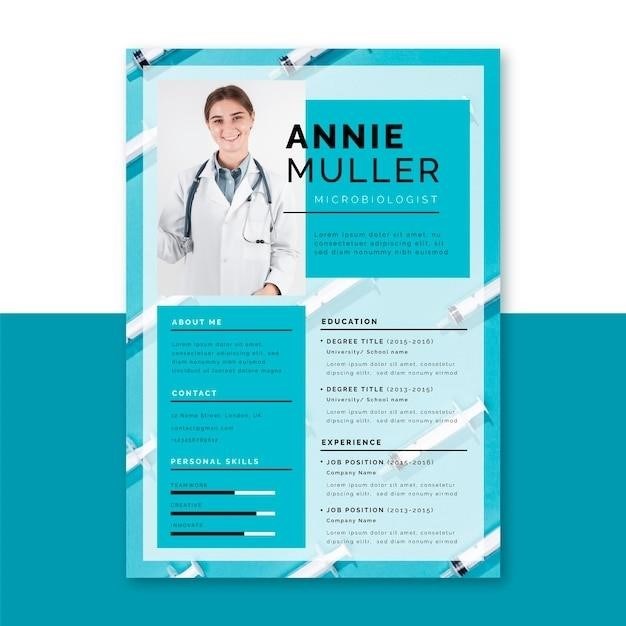
ICU Nurse Resume⁚ A Comprehensive Guide
Crafting a compelling ICU nurse resume requires showcasing both technical skills and a dedication to patient-centered care. This guide provides a structured approach to building a resume that highlights accomplishments and emphasizes value-based healthcare delivery, ultimately increasing your chances of landing your dream ICU nursing position. Downloadable PDF templates and examples are readily available online to assist in the process. Remember to tailor your resume to each specific job description, using keywords and action verbs to make your application stand out.
Crafting a Winning Summary Statement
Your resume summary statement is your first impression; make it count. In two to three concise sentences, highlight your most relevant skills and accomplishments as an ICU nurse. Instead of simply listing duties, emphasize quantifiable achievements. For example, instead of “Provided patient care,” try “Improved patient outcomes by 15% through implementation of a new monitoring protocol.” Mention certifications like CCRN (Critical Care Registered Nurse) if applicable. Showcase your expertise in areas such as hemodynamic monitoring, advanced life support, and critical care procedures. Tailor the summary to each specific job description, focusing on the keywords and requirements mentioned. A strong summary statement acts as a compelling hook, drawing the recruiter’s attention and encouraging them to delve deeper into your resume. Remember to maintain a professional tone, showcasing your passion and expertise in critical care nursing.
Highlighting Key Skills and Experience
The “Skills” and “Experience” sections are crucial for showcasing your ICU nursing capabilities. List technical skills such as hemodynamic monitoring, ventilator management, arterial line insertion, and central venous catheter insertion. Include experience with various medical equipment and technologies commonly used in ICUs. Highlight your proficiency in medication administration, including high-alert medications. Showcase your ability to manage complex patient cases, including those with multiple organ failure or severe trauma. Detail your experience with patient assessment, charting, and communication with interdisciplinary teams. Quantify your achievements whenever possible. For instance, instead of “Managed patient medications,” write “Safely and accurately administered medications to over 100 patients per month, maintaining a zero-error rate.” Use action verbs to describe your responsibilities and accomplishments, making your contributions clear and impactful.
Showcasing Accomplishments, Not Just Duties
Instead of simply listing your duties, focus on quantifiable accomplishments that demonstrate your skills and impact. For example, instead of stating “Provided patient care,” highlight achievements like “Improved patient outcomes by implementing a new pain management protocol, resulting in a 20% reduction in patient reported pain scores.” Showcase your initiative and problem-solving skills by describing instances where you went above and beyond your job description. Did you develop a new procedure that improved efficiency? Did you mentor junior nurses, leading to improved team performance? Highlight instances where you demonstrated critical thinking, quick decision-making, and effective communication under pressure. Remember, recruiters are looking for evidence of your abilities, not just a list of tasks. Use the STAR method (Situation, Task, Action, Result) to structure your accomplishments, providing a clear narrative that showcases your skills and contributions. Quantify your results whenever possible, using numbers and data to support your claims.

Resume Formatting and Design
Presentation matters! Use a clean, professional font (like Arial or Didot) and ensure one-inch margins. Maintain a one-page format for optimal readability. Prioritize white space for an uncluttered, visually appealing resume, easily downloaded and viewed as a PDF.
One-Page Resume⁚ Concise and Impactful
In the competitive landscape of ICU nursing, brevity is key. Recruiters often spend mere seconds reviewing each application; therefore, a concise, one-page resume is paramount. This format demands strategic selection of information, focusing on the most relevant skills and experiences. Avoid lengthy descriptions; instead, use impactful bullet points that quantify achievements. For instance, instead of stating “provided patient care,” quantify your contributions by saying “Improved patient outcomes by 15% through implementation of a new monitoring protocol.” Each bullet point should be a mini-success story showcasing your abilities and contributions. Remember, your goal is to make a strong, immediate impression, leaving the recruiter wanting to learn more. A well-structured one-pager achieves this by clearly highlighting your key qualifications and accomplishments, efficiently demonstrating your value as a critical care nurse. This concise format makes your resume easily digestible and increases the chances of securing an interview. A one-page resume demonstrates respect for the recruiter’s time and showcases your ability to communicate effectively and efficiently.
Utilizing Professional Fonts and White Space
The visual presentation of your ICU nurse resume is crucial. Selecting a professional font, such as Arial or Times New Roman in a size between 10 and 12 points, ensures readability across various devices. Avoid overly stylized or decorative fonts that can hinder readability and appear unprofessional. Equally important is the strategic use of white space. White space, or the blank areas on your resume, prevents a cluttered appearance and guides the reader’s eye. Adequate margins (at least one inch on all sides) and spacing between sections improve readability and create a visually appealing document. Consistent spacing between bullet points and paragraphs further enhances the overall aesthetic. Remember, a well-designed resume is easier to scan and digest, ultimately improving your chances of making a positive first impression. The balance of text and white space contributes significantly to the overall professionalism and impact of your resume. This careful attention to detail showcases your organizational skills and commitment to excellence, even in the visual presentation of your application materials.
Saving Your Resume as a PDF
Once your ICU nurse resume is finalized and meticulously proofread, saving it as a PDF (Portable Document Format) is paramount. This ensures that the formatting, fonts, and layout remain consistent regardless of the recipient’s operating system or software. Unlike other file formats like .doc or .docx, PDFs prevent unintended alterations to your carefully crafted resume. This is particularly important given the visual elements emphasized in professional resume design. Maintaining a consistent and professional presentation is key to making a strong first impression on potential employers. The PDF format guarantees that your resume will be displayed as intended, preventing formatting issues that can arise from different software interpretations. Moreover, the PDF format protects against accidental edits or changes to your resume. By saving your resume as a PDF, you maintain control over its final appearance and ensure that hiring managers see precisely what you intended them to. This attention to detail demonstrates professionalism and preparedness, qualities highly valued in the competitive field of ICU nursing.
Content and Structure
Organize your ICU nurse resume logically, prioritizing relevant experience and skills. Use clear headings and concise bullet points to highlight accomplishments. A well-structured resume ensures easy readability and impactful presentation of your qualifications.
Tailoring Your Resume to Specific Job Descriptions
To maximize your chances of getting an interview, meticulously customize your ICU nurse resume for each job application. Carefully review the job description, identifying key skills, requirements, and desired experiences. Then, strategically incorporate those specific keywords and requirements throughout your resume. For instance, if a job posting emphasizes experience with a particular medical device or treatment protocol, prominently feature your proficiency in that area. Don’t simply list your responsibilities; quantify your achievements using metrics whenever possible. Highlight instances where you exceeded expectations or contributed significantly to positive patient outcomes. This targeted approach demonstrates your understanding of the role and showcases your ability to directly address the employer’s needs. Remember to tailor your summary statement and skills section to align perfectly with the specific job description, showcasing the most relevant aspects of your experience. This personalized touch significantly increases your chances of catching the recruiter’s attention and advancing to the next stage of the hiring process. A generic resume will likely get overlooked, so take the time to make each application unique and impactful.
Emphasizing Value-Based Healthcare Delivery
In today’s healthcare landscape, value-based care is paramount. Hiring managers in the ICU setting actively seek nurses who demonstrate a commitment to improving patient outcomes and satisfaction beyond simply fulfilling duties. Therefore, your resume should showcase your contributions to this model. Instead of merely listing tasks, highlight instances where you actively reduced hospital readmissions, improved patient adherence to treatment plans, or enhanced patient and family satisfaction. Quantify your achievements whenever possible; use metrics to demonstrate the impact of your actions. For example, instead of saying “provided excellent patient care,” you might state “reduced patient complications by 15% through proactive monitoring and early intervention.” Mention any involvement in quality improvement initiatives or participation in programs aimed at improving patient experience. Highlight your ability to collaborate effectively with interdisciplinary teams to achieve shared goals and promote patient well-being. By emphasizing your contributions to value-based healthcare, you directly address the priorities of modern ICU settings and present yourself as a valuable asset to the team.
Incorporating Keywords and Action Verbs
To optimize your ICU nurse resume for Applicant Tracking Systems (ATS) and recruiter searches, strategically incorporate relevant keywords and strong action verbs. Analyze job descriptions for common terms like “hemodynamic monitoring,” “ventilator management,” “critical care,” “rapid response,” “code blue,” and “patient advocacy.” Weave these keywords naturally into your skills and experience sections, avoiding keyword stuffing. Instead of simply listing responsibilities, use action verbs to describe your accomplishments. Replace weak verbs like “responsible for” with stronger alternatives such as “managed,” “implemented,” “initiated,” “optimized,” “collaborated,” “achieved,” or “resolved.” For example, instead of writing “Responsible for administering medications,” write “Administered medications accurately and timely, ensuring patient safety and adherence to protocols.” This approach not only improves the readability of your resume but also significantly increases its chances of being noticed by ATS and recruiters, leading to more interview opportunities. Remember that a well-crafted resume using specific keywords and action verbs enhances your professional image and shows you are detail-oriented and results-driven.
